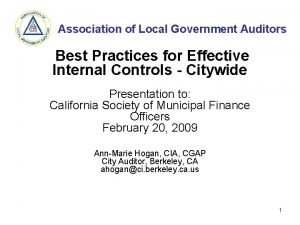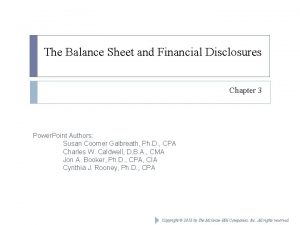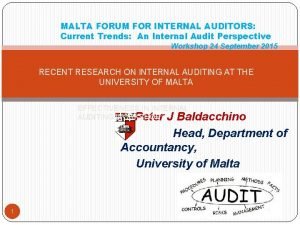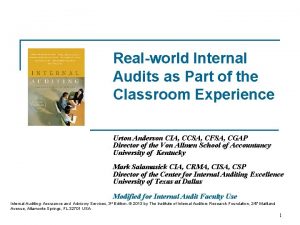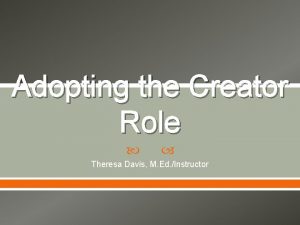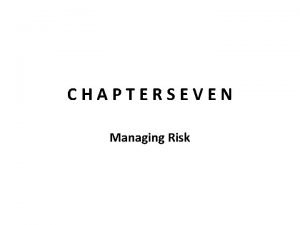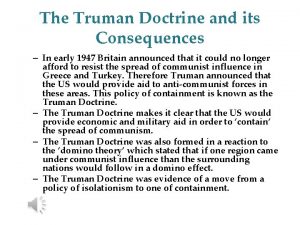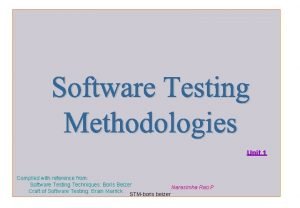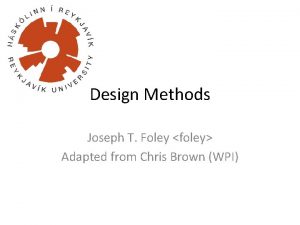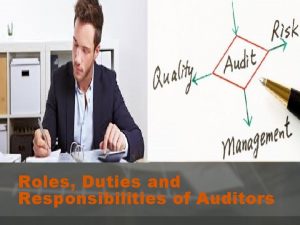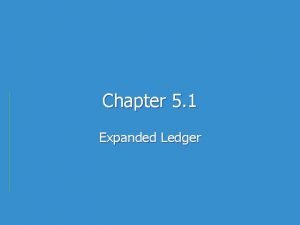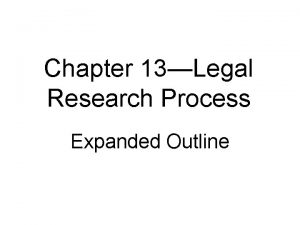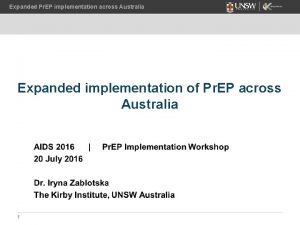Consequences of adopting an expanded auditors report in





















- Slides: 21

Consequences of adopting an expanded auditor's report in the United Kingdom Elizabeth Gutierrez, Universidad de Chile Miguel Minutti-Meza and Kay W. Tatum, University of Miami Maria Vulcheva, Florida International University Sep 15, 2017

If you remember only one thing as you leave today… The expanded auditor’s report in the UK provides additional information about auditor’s judgments However, it is unclear whether the report significantly changed the audit and its consequences in the relatively short term (+2 years) for the large companies that adopted the new rules

Worldwide move towards expanded auditor’s reports • Investors and regulators worldwide have expressed growing concerns about the content of the (public) auditor’s report • Diverse stakeholders seem interested on getting more information about the auditor’s judgments • The proposed and adopted changes follow previous requirement in the U. K. and other countries to disclose audit partners’ names

Adopters of the expanded report: London Stock Exchange, main market, premium listing • Main market is the LSE primary market for listed companies • Three types: premium, standard and high growth (AIM) • Premium listed companies must comply with the U. K. ’s highest standards of regulation and corporate governance • Less than 800 companies have PREMIUM STATUS, about a third are investment entities (funds) , and we focus only on non-financial entities

The UK expanded auditor’s report • Increased by two pages approx. 2, 400 words, compared to 760 words in the old reports • Typically four risks and 660 words, approximately 1/3 of the additional words • Revenue recognition is the predominant risk, in over 60% of the reports • Average materiality is 0. 6% and median is 0. 5% of total assets. We standardized as a % of assets to make this number comparable across all companies, however there is variation in the actual basis used by auditors

Example of risk disclosures in the first year 2013 Hilton Food Group plc Fraud in revenue recognition ISAs presume there is a risk of fraud in revenue recognition because of the pressure management may feel to achieve the planned results. We focused on the amount and timing of the recognition of revenue, particularly where the contractual customer terms provide for cost plus pricing or discounts, which are calculated by management. We tested revenue by agreeing it to supporting documentation, including customer contracts, discounts and incentives, and to cash receipts. We also tested journal entries posted to revenue accounts by identifying and challenging unusual or irregular items

Research question #1 Did investors’ react to additional disclosures? Auditor’s disclosures were not strictly directly available to investors before the new rules. Non-standard reports (GCO and other) are associated with price and trading volume reactions in previous research However: – The new disclosures are somewhat generic – Disclosures can be implied by other publicly available information – Investors may be unable to fully understand the new disclosures or possible “disclosure overload”

Research question #2 Did the cost of audits change? Additional effort and risk may make audits more expensive. Firms may have incurred both one-time and recurring costs However: – FRC expected only a small fee increase – Information on risk, materiality, and scope was already discussed with the audit committee – Audit fees reflect only part of the cost of audits if workload and fees are negotiated between clients and auditors

Research question #3 Did audit quality change? Auditors may be under more scrutiny, especially when it comes to risks, and thus increase audit quality. Carcello and Li (2013) find that after the partner is required to sign in the UK, the perceived increase in responsibility leads to higher audit quality However: – Unclear whether auditors significantly changed their methodology – Additional disclosure might serve as a disclaimer for responsibility – It might be too early to detect changes in audit quality

Difference-in-differences or incremental change PREMIUM (adopters) versus AIM UK companies AIM Non-adopters PREMIUM Adopters 2 years First 2 years new report After Sept 2013 AIM Non-adopters 2 years Before Sept 2013 PREMIUM Adopters 2 years Before Sept 2013

Why do we need a “control” group of other UK companies? Significant market run upwards around 2013

The four main outcome variables in our study 1. 2. 3. 4. Abnormal (market-adjusted) 3 -day returns Auditor’s report public date, released together with the full annual report Abnormal 3 -day trading volume Daily trading volume, adjusted for a “normal period” of daily volume before the report’s public date Audit fees Sum of audit fees for parent-company and statutory audits Absolute discretionary (unexpected) accruals Rough measure of quality, possibly only diagnostic indicator of “something” changing in total accounting estimates (NI-CFO)/Assets “adjusted for normal %” using a model

No evidence of a substantial incremental change in investors’ reaction to the public release of the report Median returns for PREMIUM companies 0. 014 0. 016 0. 015 and for AIM companies 0. 016 0. 021 0. 020 0. 025 Change is too small to conclude

No evidence of a substantial incremental change in audit fees Median Log fees for PREMIUM companies 12. 90 12. 96 13. 01 and for AIM companies 10. 69 10. 75 10. 84 10. 86 Change is too small to conclude

No evidence of a substantial incremental change in accounting estimates (NI-CFO)/Assets, adjusted for normal % Median Abn Accr for PREMIUM companies 0. 034 0. 029 0. 031 0. 035 and for AIM companies 0. 065 0. 055 0. 061 0. 060 Change is too small to conclude

#1 Issue in determining investors’ reaction Low overall reaction to annual report’s filing • The auditor’s report is included in the release of the full annual report • The release of the full annual report follows an earlier earnings announcement disclosure. For the companies in our sample the earnings announcement is a very complete form of disclosure, containing full financial statements and mentioning whether the auditor’s opinion was unqualified. • It is difficult for an audit report to add to an already rich disclosure environment

#2 Issue in determining investors’ reaction Other information in the annual report • There were other changes to corporate reporting in the UK around the same time, in particular the Corporate Governance Code in October 2012. These changes require additional audit committee disclosures • These disclosures can affect our analyses. We also consider the overlap between the auditor’s and audit committee’s disclosures and reach similar conclusions • There is always a chance that our measures are “too coarse” to capture an effect, however they are standard in accounting and audit research

However audit fees and risks in the report are linked (+) There is an association between auditor effort (fees) and the auditor’s assessment and disclosure of audit issues. If the risk disclosures were entirely boilerplate or “empty” we would not find this association

Also, abnormal accruals and materiality are associated (+) However, there is also association between auditor effort (small materiality) and the magnitude of abnormal accruals (small abnormal accruals)

Finally, auditors are responsive to feedback! See the changes between first and second year

Summary and final thoughts 1. We document a statistically undetectable change on investors’ reaction around the public release date of the report, audit fees, and audit quality. The expanded report does not seem to disrupt the way audits are conducted or the market for audits in the UK 2. However, risk and materiality are predictably related to audit fees and quality. Arguably, if risks and materiality disclosures were strictly “empty” or boilerplate, they would not be associated with these outcomes 3. Perhaps there will be a long-term impact (change in behavior) that we cannot yet determine, or the report may be more informative for smaller companies with comparatively less oversight than the UK Premium companies
 Association of local government auditors
Association of local government auditors Escola oberta auditors
Escola oberta auditors The auditors
The auditors Peter j baldacchino
Peter j baldacchino Internal auditors ely
Internal auditors ely Traineeship european court of human rights
Traineeship european court of human rights Adopting lifelong learning
Adopting lifelong learning Adopting the creator role
Adopting the creator role Adopting materials
Adopting materials Contoh soal adopting a different point of view
Contoh soal adopting a different point of view By adopting a sociological imagination
By adopting a sociological imagination Timothy is writing an essay about adopting pets
Timothy is writing an essay about adopting pets Adopting proven technology instead of experimental
Adopting proven technology instead of experimental Adopting lifelong learning
Adopting lifelong learning Consequences of the truman doctrine
Consequences of the truman doctrine The truman doctrine worksheet answers
The truman doctrine worksheet answers Dichotomies in stm
Dichotomies in stm In your notebook write consequences of these situations
In your notebook write consequences of these situations Unintended consequences
Unintended consequences Consequences of the 100 years war
Consequences of the 100 years war Are manners important
Are manners important Choices have consequences philosophy
Choices have consequences philosophy
